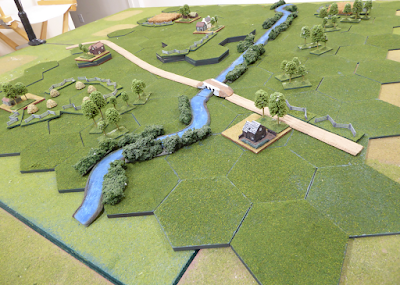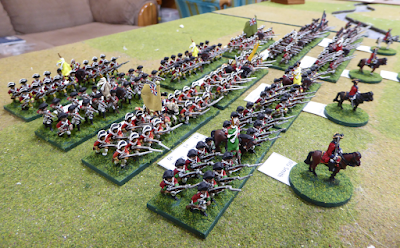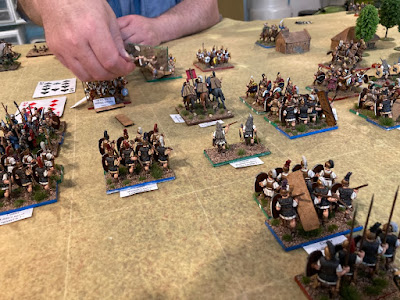Bob Cordery's latest publication contains two sets of rules. One of the rules included is a version of his The Portable Wargame adapted for use in the Spanish Civil War. While I have The Portable Wargame, The Portable Spanish Civil War Wargame is new to me.
Graham wanted to give the rules a run-through during this week's remote gaming session. That is what we did. For Graham's post-game battle reports, please visit, Portable Spanish Civil Wargaming. Since Graham's battle reports are comprehensive and offer a good summary of the action in both play-throughs, I focus on the Republican strategies for Scenario 1 for which I was placed in command.
Scenario 1 Attack of the Columns (1936)
In scenario 1, the Republicans set up their forces first. The Nationalists enter the table at E on Turn 1. The victory conditions seem unclear but we assumed that the Nationalists must get at least one unit to the top of the map to win.
 |
Scenario Map |
Given the force compositions and victory conditions, I chose the initial deployments illustrated below.
 |
| Republican deployment |
What is the plan after initial deployment and the enemy arrives on board? Will this plan survive contact with the enemy? This deployment provides a number of options as seen in the diagram below.
 |
| Covering all of the bases |
In Game 1, the Nationalists opted for a flanking plan on the Republican right. One twist to the game was that the Republicans won the initiative on Turn 1. With no Nationalists on table, this meant that initiative actually passed over to the Nationalists as there was nothing the Republicans could do. In effect, winning the initiative gives the initiative to your opponent. To compound this oddity, winning the initiative opens up the chance that the enemy will get a double move by winning the initiative on Turn 2. Yep. This is exactly what happened!
How did this plan work in practice?
 |
| Nationalists begin a left hook |
 |
| Republicans call in an airstrike. |
 |
| Transport destroyed and commander pinned. |
 |
| With a double turn, the trucks race for the map edge. |
 |
| Not so fast! Another airstrike. |
 |
| With transports blown-up and enemy pinned, the Asaltos attack. |
In Game 2, the Republicans only altered one unit's position. That change was to move the Asaltos one hex to the NW to thwart a left hook drive off map. The Nationalists countered with a right hook attack. Same result. The Nationalists reached their Exhaustion Point before any units could approach the top map edge. Of course, the Nationalist defeat was aided by the elimination of its commander as he rallied his troops.
With few units, the Republicans have few viable options as to where to place their troops initially. This deployment takes into account all enemy avenues of approach and allows a good chance to defeat the enemy before it can race off map.
Maybe next time we examine optimal play for checkers?








































